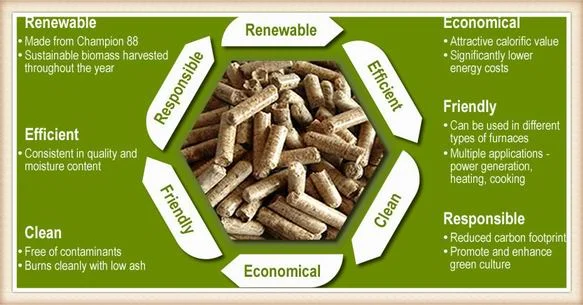Future of Biomass Pellets in Haryana and Himachal Pradesh
Biomass pellets are biofuels made from compressed organic materials. These organic materials can include various types of biomass, such as wood, agricultural residues, crop waste, grasses, and other plant matter. The biomass pellets in Haryana is processed and compacted into small pellet shapes, usually around 6-10 millimeters in diameter and a few centimeters in length.
The process of making biomass pellets involves grinding the raw biomass material into a fine powder, then applying pressure to the powder to form dense pellets without the need for binders or additives. The resulting pellets have a high energy density and are easy to handle, transport, and store. They can be used for heating purposes in residential, commercial, and industrial settings, as well as in some power generation applications.
Despite the promising prospects, several challenges hinder the widespread adoption of biomass pellets in Haryana and Himachal Pradesh. Infrastructure constraints, lack of awareness, and financing barriers are some of the key challenges that need to be addressed.
The use of biomass pellets as a biofuel source is considered environmentally friendly because the carbon dioxide released during combustion is roughly equivalent to the carbon dioxide absorbed by the plants during their growth, creating a carbon-neutral cycle.
WHY BIOMASS PELLET IS USED?
Biomass pellets are used for several reasons due to their various benefits and advantages:
Renewable Energy Source: Biomass is a renewable resource, as it comes from organic materials that can be replenished through sustainable forestry and agricultural practices.
Carbon Neutral: When biomass pellets are burned, they release carbon dioxide, but this is generally offset by the carbon dioxide absorbed by the plants during their growth. This makes biomass pellets a carbon-neutral or low-carbon energy source compared to fossil fuels.
Reduced Greenhouse Gas Emissions: Biomass pellets produce fewer greenhouse gas emissions compared to traditional fossil fuels like coal, oil, and natural gas. This helps in mitigating climate change and reducing overall environmental impact.
Waste Management: Biomass pellets can be made from various types of waste materials, such as wood residues, agricultural byproducts, and other plant waste. This provides a way to utilize materials that might otherwise be discarded.
Energy Efficiency: Biomass pellets have a high energy density and consistent quality, making them efficient for combustion. Their uniform size and shape allow for automated feeding and combustion in heating systems.
Local Energy Production: Biomass pellets can be produced locally, reducing dependence on imported fossil fuels and promoting regional energy self-sufficiency.
Versatility: Biomass pellets can be used for various applications, such as residential and commercial heating, industrial processes, and electricity generation in specially designed power plants.
Job Creation: The production, transportation, and use of biomass pellets can create employment opportunities in rural and agricultural areas.
Incentives and Subsidies: Many governments and organizations offer incentives, grants, and subsidies for using biomass pellets in Haryana and Himachal Pradesh as a renewable energy source, encouraging their adoption.
Biomass Pellet Eco-System


Reduced Air Pollution: Biomass pellets generally emit fewer pollutants, such as sulfur dioxide and particulate matter, compared to traditional fossil fuels, leading to improved air quality.
Diversification of Energy Sources: Using biomass pellets diversifies the energy mix, reducing reliance on fossil fuels and contributing to a more resilient energy system.
Stimulating Local Economies: Biomass pellet production can contribute to local economic development by providing markets for locally sourced biomass materials and creating jobs.
Long-Term Energy Security: Biomass resources can be managed sustainably, providing a stable source of energy in the long term.
Overall, biomass pellets are used as a cleaner and more sustainable alternative to fossil fuels, addressing both energy needs and environmental concerns. However, it’s important to ensure that biomass is sourced and produced in a responsible and sustainable manner to fully realize these benefits.
